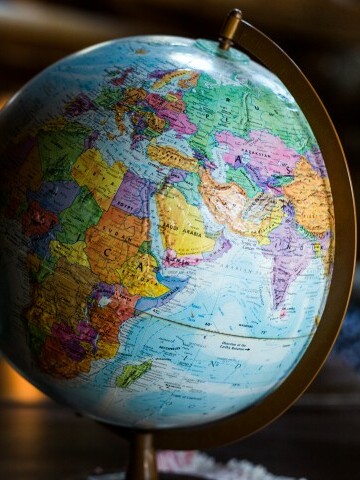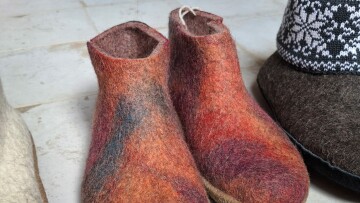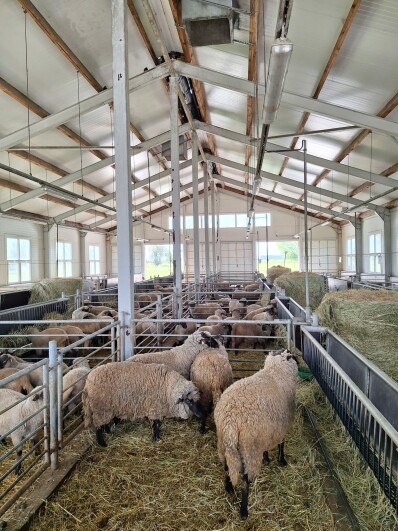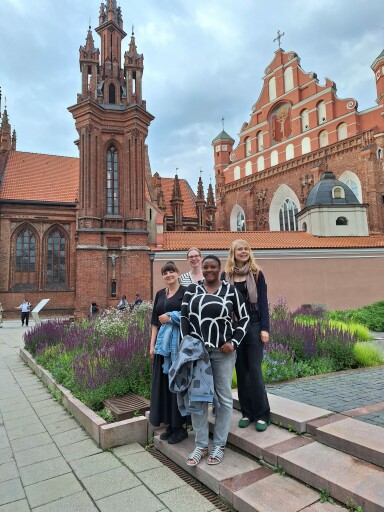
Bloggar
Wool trip to Lithuania: Using local wool is challenging

Why is so much sheep wool thrown away? Could coarser wool not suitable for being worn next to skin be used for other things, like felted products? The Nordic-Baltic project F.E.L.T. WOOL – Future Emergence of Local Textiles based on WOOL is up for finding answers to these questions. In the beginning of June 2024, the project made its first study visit with representatives from all partner countries: Norway, Sweden, Finland, Estonia and Lithuania. This time the journey went through Vilnius to other Lithuanian towns and villages with wool processing companies and some sheep breeders. The visit was organized by the Lithuanian partner organization Viva Sol and their CEO, Lina Gumbrevičienė. The organization works to enhance the vitality in rural areas.
Who is there to take the wool further?
In Lithuania, the knowledge about wool and other natural fibers seems to be relatively high. There are smaller companies working with wool with their hands or with small-scale machines, and large companies like the Lithuanian-Danish company Litspin, processing 100 000 tons of wool and other fibers annually. However, most companies we visited buy washed wool from abroad. The reasons for not using native wool are the same as in Finland and many other countries. Washed wool in large quantities, with an even quality, is available at a relatively low cost, ready for spinning or felting, when bought from large suppliers abroad. Compared to this, collecting wool from local farms, sorting the different qualities, getting rid of the unusable wool and then washing what is left requires much more time and resources. Now, there is no native company or organization doing this. As a representative of the Association of Sheep Breeders of Lithuania put it: “The sheep breeders bring up the sheep, but who is there to take the wool further?”. The association and genetic center are running a farm with about 2000 sheep, maintaining the native breeds Lithuanian Black-headed and Lithuanian Coarse wooled sheep. They also offer resources for researchers and produce knowledge for the farming community.

Lithuanian black headed sheep. Photo: Ulrika Dahlberg
A refreshing exception to the companies using foreign wool was the small family business Alka Wool using alpaca wool from Lithuanian alpaca breeders and wool from native breeds. The very energetic owner, probably in his 70’s, told us that the wool from the native breeds is the best in the world for felting. He has small-scale machines for everything from washing to carding, sells carded wool and manufactures blankets and pillows filled with wool. In addition to that he has installed solar panels outside the business facility and is now fulfilling his childhood dream of digging his own pond in the yard, for recreation.
Recycled and virgin wool
Another question, in addition to that of using native or imported wool, is whether companies should use virgin or recycled fibers. Recycling of different materials is supported and invested in by many different actors in Europe and beyond and recycled materials are often cheaper to use. In Lithuania, we had the opportunity to visit Neaustima UAB, one of the biggest manufacturers of nonwovens and recyclers of textile waste into fibers in the Baltic states. Products are exported to countries in Europe and North America. The recycled materials are post-industrial but pre-consumer, i.e. left over from industrial production but have not been used by private consumers before. We even got to see a heap of textile waste from Finland at the factory, on its way to being remade into new materials.
For virgin wool needle punch felted products Neaustima has mostly been using wool from New Zealand and England, but also some from Estonia. Only natural colors are used, since it is challenging to keep multiple colors in stock. The most important things for the company are that the wool is well washed, uniform color, and that the microns indicating fineness/coarseness are right for the product. Lithuanian wool was tried out once, but it was difficult because there is no collection or washing system for it, and the wool contained lots of dirt and grease. Some education of farmers is done to improve wool quality, but the right company for washing and sorting needs to be found to get things going. The Neaustima company itself does not care about where the wool is from, as it manufactures products only on demand from customers. Mixes of wool and polyester are popular, but there is also a possibility to mix wool with other natural materials, such as flax and hemp if the customer wishes so.
The company representatives tell us that there has been less demand for products made from wool in recent years. One reason can be that life cycle analyses show wool in a bad light, because of methane emissions. The customers that buy materials from Neaustima often want to show they are circular, green and responsible, and even wish for the materials to look recycled i.e. have mixed colors instead of being pure white. This is a result of trends and policy.
Recycling is a good thing and should be supported. Being sustainable, on a broader scale, also involves supporting the local community, economy, biodiversity, carbon sequestration and landscape. Using wool from grazing, locally raised sheep does this. Developing products of this wool, even if it is called virgin, reduces waste because the wool is produced anyway as a part of meat production and sheep breeding, and is being thrown away if not used by anyone. Using both virgin and recycled wool, like Neaustima does, is of course possible, and probably the most sensible thing to do. How to get in the local wool in this equation is still a tricky question. What a small project can do is limited, but creating networks in the Nordic and Baltic countries is one step forward.
F.E.L.T. WOOL is a networking and knowledge project financed by Nordplus Horizontal. The project aims to gather information about felting and the usage of coarser wool, to learn about businesses and associations that work with local sheep breeds and wool. The goal is to share knowledge and create a network between Nordic and Baltic countries, to help businesses and local entrepreneurs find new ways to use wool that might otherwise be thrown away. Hopefully this can inspire individuals, industry and organizations to improve and reduce waste in the wool industry. The project is led by Selbu Spinneri in Norway.
![]()

Team Finland in Vilnius: Piritta Mäkinen, Ijeoma Omeoga, Heidi Barman-Geust and Ulrika Dahlberg. Photo: Nina Alsborn
Bioekonomi
Blogginlägg som är granskat av Novias redaktionsråd är utmärkta med nyckelordet "Granskat inlägg".
Vi följer CC-BY 4.0 om inget annat nämns.
Ansvarsfriskrivning: Författaren/författarna ansvarar för för fakta, möjlig utebliven information och innehållets korrekthet i bloggen. Texterna har genomgått en granskning, men de åsikter som uttrycks är författarens egna och återspeglar inte nödvändigtvis Yrkeshögskolan Novias ståndpunkter.
Disclaimer: The author(s) are responsible for the facts, any possible omissions, and the accuracy of the content in the blog.The texts have undergone a review, however, the opinions expressed are those of the author and do not necessarily reflect the views of Novia University of Applied Sciences.